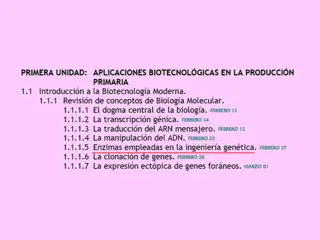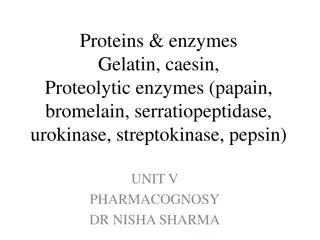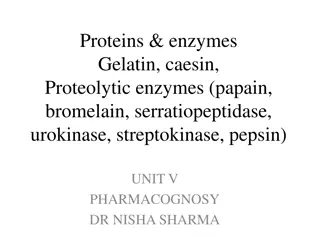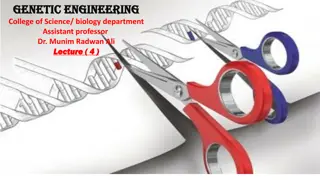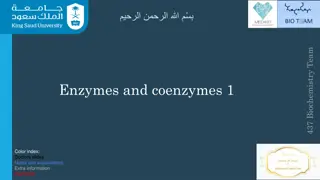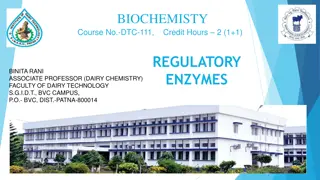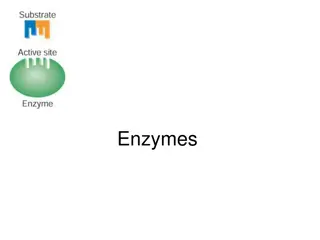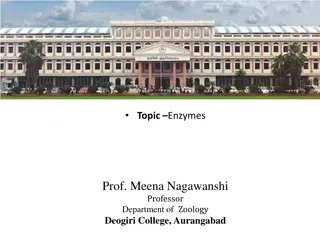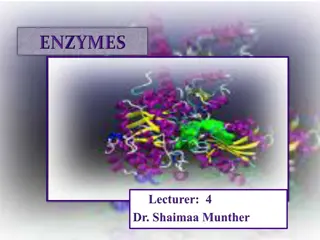Understanding Enzymes: Importance and Clinical Applications
Enzymes are vital proteins that speed up chemical reactions without being consumed, playing a crucial role in various physiological processes. They require cofactors for optimal function, and their levels in blood can indicate tissue damage or disease. Learning about enzymes is essential for understanding biochemical reactions and their implications in clinical medicine.
Download Presentation

Please find below an Image/Link to download the presentation.
The content on the website is provided AS IS for your information and personal use only. It may not be sold, licensed, or shared on other websites without obtaining consent from the author. Download presentation by click this link. If you encounter any issues during the download, it is possible that the publisher has removed the file from their server.
E N D
Presentation Transcript
ENZYMES Learninig Objectives: 1. Define enzymes. 2-Describe the biomedical importance of enzymes. 3. To illustrate the general properties of enzymatic reactions.
Enzymes :are proteins that increase the rate of chemical reaction by lowering the energy of activation but do not alter the equilibrium constants of the reaction they catalyze. They catalyze nearly all the chemical reactions taking place in the cells of the body. Not altered or consumed during reaction. Reusable
Many enzymes require the presence of other compounds - cofactors - before their catalytic activity can be exerted. This entire active complex is referred to as the Holoenzyme; apoenzyme (protein portion) plus the cofactor (coenzyme, prosthetic group or metal-ion activator) is called the holoenzyme. Apoenzyme + Cofactor = Holoenzyme
Cofactor :Anon- protein prosthetic group ,are generally metal iones that must be bound to the enzyme to maintain the correct configuration of the enzyme active site. Metal cofactors may bound reversibly or tightly to enzymes. Reversible binding occurs in metal activated enzymes (e.g. magnesium in kinases and phosphotransferase). Coenzymes -. Are organic groups that generally serve as carriers of electrons or chemical groups. its a non protein, low Mwt, heat stable substance binding loosely with the enzyme and regenerated after the reaction. Examples : Nicotine amideadeninedinucleotide(NAD).
Enzymes in clinical medicine 1-Diagnosis and prognosis of diseases Changes in concentration and activity of plasma enzymes reflect changes that have occurred in a particular tissue or organ. Plasma enzymes are of two types: 1-Functional enzymes: synthesized in the liver and present in the blood in high concentration . 2-Non-functional plasma enzymes: intracellular enzymes present in very low levels in the blood (in healthy state) and has no function. They are released in the plasma as a result of cellular damage (e.g myocardial infarction &hepatitis)
Non-Functional plasma enzymes Functional plasma enzymes Present in plasma in higher concentrations in comparison Normally, present in plasma in very low concentrations in comparison to tissues No known functions Concentration in plasma to tissues functions Have known functions Their substrates are always present in the blood Their substrates are absent from the blood substrates Different organs e.g. liver, heart, brain and skeletal muscles Site of synthesis Liver Different enzymes increase in different organ diseases Effect of diseases Decrease in liver diseases Clotting factors e.g. prothrombin,and ipoprotein lipase ALT, AST, CK, LDH, alkaline phosphatase, acid phosphatase and amylase, Examples
Diagnostic Importance of Enzymes: Plasma enzyme measurement is an important diagnostic tool for many diseases. Examples: A: CK-MB Isozyme in acute myocardial infarction. B: Amylase in acute pancreatitis. C: Acid phosphatase in prostatic cancer. D: ALT, AST, -GT and alkaline phosphatase in liver diseases. Prognosis of the disease; we can follow up the effect of treatment by measuring plasma enzymes before and after treatment.
2-Some enzymes are used as Therapeutic agents Streptokinase: Used in clearing blood clots in myocardial infarction Enzyme prepared from streptococcus Plasmin cleaves fibrin into several soluble components Act by activating plasminogen to form plasmin.
Asparaginase: enzyme used in therapy of adult leukemia ,.
3-Use of Enzymes in determination of Metabolites of clinical importance . Determination of Glucose oxidase glucose estimation Uricase Urease Urea Cholesterol oxidase cholesterol Lipase triglycerides Enzymes used in ELISA ---technique . uric acid
4). To study the metabolic pathways in the body and their regulation. 5. The study of regulation of enzyme activity aid in understanding biochemical sciences and diseases such as: Cancer Heart disease Hormone action Drug action.
General Properties of Enzymatic Reactions 1. Enzymes have enormous ( very high) catalytic power. Example : Carbonic anhydrase CO2+ H2O H2CO3 The enzyme can hydrate 105Co2molecules in one second , and the enzyme catalysed reaction is 107faster than the uncatalysed one.
2. Enzymes are highly specific. The ability of an enzyme to catalyze a particular reaction of a compound or class of a compounds is called its Specificity. Types of enzyme specificity: Stereospecificity Reaction specificity Substrate specificity : 1-Absolute substrate specificity 2-Relative substrate specificity
Stereospecificity or optical specificity Stereoisomers are the compounds which have the same molecular formula, but differ in their structural configuration The enzymes act only on one isomer and, therefore, exhibit stereo specificity. Most of the enzymes of the human body show stereochemical specificity .Because we use only D- sugare and L-amino acids,the enzymes involved in digestion and metabolism recognize only those particular stereoisomers.
Reaction specificity The same substrate can undergo different types of reactions, each catalysed by a separate enzyme and this is referred to as reaction specificity. An amino acid can undergo transamination, oxidative deamination, decarboxylation, etc. The enzymes however, are different for each of these reactions.
Substrate specificity Absolute substrate specificity: Certain enzymes act only on one substrate e.g. glucokinase acts on glucose to give glucose 6 - phosphate, urease cleaves urea to ammonia and carbon dioxide
Relative substrate specificity In this type the enzyme act on more than one substrate A-Bond Specificity: In this type, enzyme acts on substrates that are similar in structure and contain the same type of bond. Most of the proteolytic enzymes are showing group (bond) specificity. E.g. Amylase which acts on -1-4 glycosidic ,bond in starch ,dextrin and glycogen, shows bond specificity.
Group Specificity: In this type of specificity, the enzyme is specific not only to the type of bond but also to the structure surrounding it. Example: Pepsin is an endopeptidase enzyme, that hydrolyzes central peptide bonds in which the amino group belongs to aromatic amino acids e. g phenyl alanine, tyrosine and tryptophan.
3. Enzymatic reactions are generally reversible. Most enzymatic reactions in the body are reversible. However, reactions in rate- limiting steps in the metabolic pathways are irreversible to control these pathways.
4. Enzymes reduces the activation energy of chemical reactions. Example: a reaction A This reaction occurs when certain fraction of " A " molecules at any given instant posses enough energy to attain an activated state called Transition state, at which the probability is very high that a chemical bond is made or broken to the product ( P) . This state is at the top of the barrier of energy separating the reactants and products. B
The free energy of activation ( G) is the amount of energy required to bring all molecules in one mole of a substance at given temperature to transition state at the top of energy barrier. Enzymes combine transiently with reactants to produce a transition state having lower energy of activation than that of uncatalyzed reaction. Thus , enzymes accelerate chemical reactions by lowering activation energy .
5. Enzymes does not alter reaction equilibrium. Example: A + B C + D K= [ C ] [ D ] K :equilibrium constant [ A ] [ B ] Enzymes does not change " K " of the reaction, but reduces the time required to attain equilibrium.
6. Enzymes transforms different kinds of energy. 7. Enzyme activity is precisely regulated.







